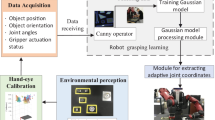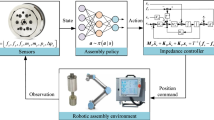Abstract
In current small batch and customized production mode, the products change rapidly and the personal demand increases sharply. Human-robot cooperation combining the advantages of human and robot is an effective way to solve the complex assembly. However, the poor reusability of historical assembly knowledge reduces the adaptability of assembly system to different tasks. For cross-domain strategy transfer, we propose a human-robot cooperative assembly (HRCA) framework which consists of three main modules: expression of HRCA strategy, transferring of HRCA strategy, and adaptive planning of motion path. Based on the analysis of subject capability and component properties, the HRCA strategy suitable for specific tasks is designed. Then the reinforcement learning is established to optimize the parameters of target encoder for feature extraction. After classification and segmentation, the actor-critic model is built to realize the adaptive path planning with progressive neural network. Finally, the proposed framework is verified to adapt to the multi-variety environment, for example, power lithium batteries.
Similar content being viewed by others
References
LIU Z H, WANG X R, CAI Y J, et al. Dynamic risk assessment and active response strategy for industrial human-robot collaboration [J]. Computers & Industrial Engineering, 2020, 141: 106302.
HUANG J, PHAM D T, LI R Y, et al. An experimental human-robot collaborative disassembly cell [J]. Computers & Industrial Engineering, 2021, 155: 107189.
RENU R S, MOCKO G. Computing similarity of text-based assembly processes for knowledge retrieval and reuse [J]. Journal of Manufacturing Systems, 2016, 39: 101–110.
DARVISH K, WANDERLINGH F, BRUNO B, et al. Flexible human-robot cooperation models for assisted shop-floor tasks [J]. Mechatronics, 2018, 51: 97–114.
ABUDUWEILI A, LI S Y, LIU C L. Adaptable human intention and trajectory prediction for human-robot collaboration [DB/OL]. (2019-09-11). https://arxiv.org/abs/1909.05089.
CHENG Y J, SUN L T, LIU C L, et al. Towards better human robot collaboration with robust plan recognition and trajectory prediction [DB/OL].(2020-02-17). https://arxiv.org/abs/1903.02199.
LIU H Y, WANG L H. Collision-free human-robot collaboration based on context awareness [J]. Robotics and Computer-Integrated Manufacturing, 2021, 67: 101997.
AMORIM A, GUIMARES D, MENDONA T, et al. Robust human position estimation in cooperative robotic cells [J]. Robotics and Computer-Integrated Manufacturing, 2021, 67: 102035.
MAKRIS S, KARAGIANNIS P, KOUKAS S, et al. Augmented reality system for operator support in human-robot collaborative assembly [J]. CIRP Annals, 2016, 65(1): 61–64.
RAATZ A, BLANKEMEYER S, RECKER T, et al. Task scheduling method for HRC workplaces based on capabilities and execution time assumptions for robots [J]. CIRP Annals, 2020, 69(1): 13–16.
LIU H Y, WANG L H. Human motion prediction for human-robot collaboration [J]. Journal of Manufacturing Systems, 2017, 44: 287–294.
BERG J, RECKORDT T, RICHTER C, et al. Action recognition in assembly for human-robot-cooperation using hidden Markov models [J]. Procedia CIRP, 2018, 76: 205–210.
LI Z, JIN X L, JIA H Y, et al. The knowledge representation and reuse in product design [J]. Journal of Shanghai Jiao Tong University, 2006, 40(7): 1183–1186 (in Chinese).
HE L L, GUO W, JIANG P Y. A decision-making model for knowledge collaboration and reuse through scientific workflow [J]. Advanced Engineering Informatics, 2021, 49: 101345.
ARANA-AREXOLALEIBA N, URRESTILLA-ANGUIOZAR N, CHRYSOSTOMOU D, et al. Transferring human manipulation knowledge to industrial robots using reinforcement learning [J]. Procedia Manufacturing, 2019, 38: 1508–1515.
RAZIEI Z, MOGHADDAM M. Adaptable automation with modular deep reinforcement learning and policy transfer [J]. Engineering Applications of Artificial Intelligence, 2021, 103: 104296.
RODRÍGUEZ I, NOTTENSTEINER K, LEIDNER D, et al. Pattern recognition for knowledge transfer in robotic assembly sequence planning [J]. IEEE Robotics and Automation Letters, 2020, 5(2): 3666–3673.
GUO M H, CAI J X, LIU Z N, et al. PCT: Point cloud transformer [J]. Computational Visual Media, 2021, 7(2): 187–199.
Author information
Authors and Affiliations
Corresponding author
Additional information
Foundation item: the National Key Research and Development Program of China (No. 2019YFB1706300), and the National Natural Science Foundation of China (No. 52075094)
Rights and permissions
About this article
Cite this article
Lü, Q., Liu, T., Zhang, R. et al. Generation Approach of Human-Robot Cooperative Assembly Strategy Based on Transfer Learning. J. Shanghai Jiaotong Univ. (Sci.) 27, 602–613 (2022). https://doi.org/10.1007/s12204-022-2493-7
Received:
Accepted:
Published:
Issue Date:
DOI: https://doi.org/10.1007/s12204-022-2493-7
Key words
- human-robot cooperation
- strategy transfer
- reinforcement learning
- progressive neural network
- power lithium battery




